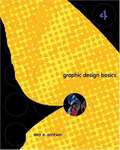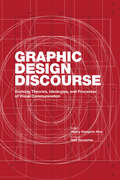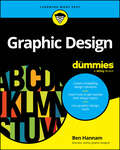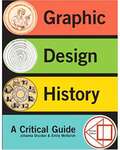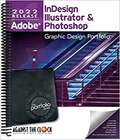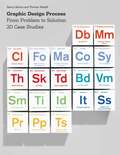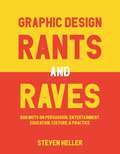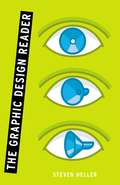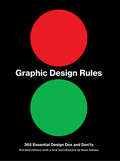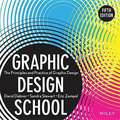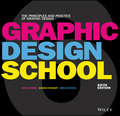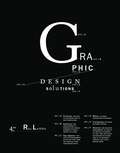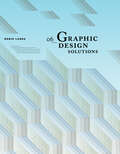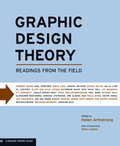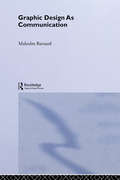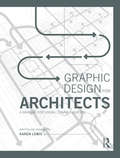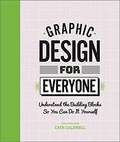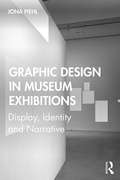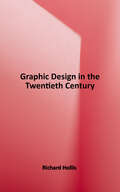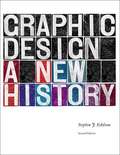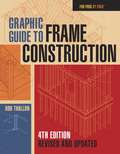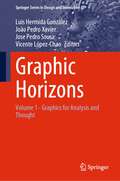- Table View
- List View
Graphic Design Basics (Fourth Edition)
by Amy E. ArntsonThe text combines history, current technology, and design principles to give a rich, well-rounded view of this ever-evolving field.
Graphic Design Discourse: Evolving Theories, Ideologies, and Processes of Visual Communication
by Henry KimIf the aim of graphic design is to communicate meaning clearly, there's an irony that the field itself has struggled between two contradictory opposites: rote design resulting from a rigorous, fixed set of rules, and eccentric design that expresses the hand of the artist but fails to communicate with its audience. But what if designers focused on process and critical analysis over visual outcome? Through a carefully selected collection of more than seventy-five seminal texts spanning centuries and bridging the disciplines of art, architecture, design history, philosophy, and cultural theory, Graphic Design Discourse: Evolving Theories, Ideologies, and Processes of Visual Communication establishes a new paradigm for graphic design methodologies for the twenty-first century. This illuminating anthology is essential reading for practicing designers, educators, and students trying to understand how to design in a singular, expressive way without forgoing clear and concise visual communication.
Graphic Design For Dummies
by Ben HannamThe complete, full-color graphic design guide for beginners The field of graphic design is constantly evolving, with new design tools, methods, technology, and modes of expression being introduced all the time. Graphic Design For Dummies will teach you how to get started, introducing you to basic design principles as well as the latest best practices, software, and trends. You'll learn how to successfully plan and execute compelling design projects, even if you're not a trained designer. This fun and friendly book will empower you with the information you need to create design solutions. You'll also have the opportunity to test your skills with a series of interactive design activities, starting with step-by-step guidance and slowly building up your skills until you're ready to fly solo. Unleash your inner graphic designer with this Dummies guide. Create compelling visuals for a wide range of tasks and purposes Learn the basic concepts of graphic design and get the tools you need to start Get hands-on experience by following tutorials to create great designs Become proficient in graphic design—no art degree needed Graphic Design For Dummies is a practical and user-friendly resource for those looking to create better design solutions quickly.
Graphic Design History
by Johanna Drucker Emily McVarishGraphic Design History, second edition, is a critical approach to the history of graphic design. Organized chronologically, the book demonstrates the connection to the current practices of graphic arts, visual expression, and design with its engaging narrative and special features. <p><p> With new images, chapter revisions, and features like Tools of the Trade, the authors stay true to connecting what designers do every day to a history of innovative graphic forms and effects. Instructor PowerPoints featuring nearly all of the images from the text make class preparation easier than ever with this new edition. <p><p> A better teaching and learning experience<p> This program will provide a better teaching and learning experience– for you and your students. Here’s how: <p><p> Improve Critical Thinking ― Chapters are framed by critical issues and historical themes so that students can fully grasp an understanding of the history of graphic design. <p> Engage Students ― Timelines and images with detailed captions easily highlight relevant information for students.<p> Support Instructors ― high resolution PowerPoint are available for this text.
Graphic Design Portfolio 2022: Adobe InDesign, Illustrator and Photoshop
by Against The ClockThe tight integration between different Adobe CC applications makes it easier than ever to create professional design for print. <p><p>This book provides a solid foundation in the three most popular software applications – Photoshop, Illustrator, and InDesign. The projects in this book were designed to represent a range of jobs you will likely encounter during your career in graphic design. You will learn to: <p> • Customize and manage the user interface in Adobe CC applications to enhance productivity. <p> • Define appropriate file dimensions and resolution for a variety of different print jobs. <p> • Use Photoshop’s powerful controls for compositing images and graphics, correcting colors, adjusting lighting, and repairing visual damage in images. <p> • Use Illustrator’s enhanced toolset to create custom vector graphics from both basic shapes and complex Bezier curves. <p> • Use InDesign’s sophisticated options to combine various elements — including text, colors, images, and graphics — into finished compositions with settings that are appropriate for commercial printing.
Graphic Design Process: From Problem to Solution
by Nancy SkolosThe process of creating graphic design cannot be easily defined: each designer has their own way of seeing the world and approaching their work. Graphic Design Process features a series of in-depth case studies exploring a range of both universal and unique design methods. Chapters investigate typical creative strategies – Research, Inspiration, Drawing, Narrative, Abstraction, Development and Collaboration – examining the work of 23 graphic designers from around the world. Work featured includes projects by Philippe Apeloig, Michael Bierut, Ed Fella, James Goggin, Anette Lenz, Johnson Banks, Me Company, Graphic Thought Facility, Ahn Sang-Soo and Ralph Schraivogel. This book is aimed at students and educators, as well as practising designers interested in the working methodologies of their peers.
Graphic Design Process: From Problem to Solution
by Nancy Skolos Thomas WedellThe process of creating graphic design cannot be easily defined: each designer has their own way of seeing the world and approaching their work. Graphic Design Process features a series of in-depth case studies exploring a range of both universal and unique design methods. Chapters investigate typical creative strategies – Research, Inspiration, Drawing, Narrative, Abstraction, Development and Collaboration – examining the work of 23 graphic designers from around the world. Work featured includes projects by Philippe Apeloig, Michael Bierut, Ed Fella, James Goggin, Anette Lenz, Johnson Banks, Me Company, Graphic Thought Facility, Ahn Sang-Soo and Ralph Schraivogel. This book is aimed at students and educators, as well as practising designers interested in the working methodologies of their peers.
Graphic Design Rants and Raves: Bon Mots on Persuasion, Entertainment, Education, Culture, and Practice
by Steven HellerDesign is everywhere. Graphic design enters into everything. This is the scope of designer Steven Heller's latest essay anthology that covers the spectrum of graphic design and related art and culture. Looking at design as practice, language, culture, and power, each of the forty-plus essays is a self-contained story. Heller pours out his ideas-criticisms and celebrations-on such topics as:A history of our modern Hindu-Arabic numerals, and a look at the letter KBrand design utilized by Hillary Clinton and Donald Trump early in the 2016 Presidential raceThe tumultuous relationship between design and sexThe Charlie Hebdo massacre and the principles of free expressionIcons revisited, including Paul Rand (not to be confused with the politician Rand Paul), Ralph Ginzburg, Frank Zachary, George Lois, and Print magazineFood packaging, the design of milk, and USPS stampsThe obsessive use of cuteness, and the sad and happy history of the ubiquitous happy face From commercial advertising to government institutions to cultural revolution, from the objects that push design forward to those that seep into the everyday, Graphic Design Rants and Raves is an exploration of how visual design has arrived in the twenty-first century.Allworth Press, an imprint of Skyhorse Publishing, publishes a broad range of books on the visual and performing arts, with emphasis on the business of art. Our titles cover subjects such as graphic design, theater, branding, fine art, photography, interior design, writing, acting, film, how to start careers, business and legal forms, business practices, and more. While we don't aspire to publish a New York Times bestseller or a national bestseller, we are deeply committed to quality books that help creative professionals succeed and thrive. We often publish in areas overlooked by other publishers and welcome the author whose expertise can help our audience of readers.
Graphic Design Reader
by Steven HellerFrom the lost art of show-card writing and the tumultuous days of guerrilla magazine publishing to the latest in electronic leaflet design and hot magazine covers, acclaimed graphic designer and author Steven Heller provides dozens of stunning examples of how graphic design has transformed from a subset of pop culture to a cultural driving force on its own.
Graphic Design Rules: 365 Essential Design Dos and Don'ts
by Tony Seddon Sean Adams Peter Dawson John FosterDON'T use comic sans (except ironically!) but DO worship the classic typefaces like Helvetica and Garamond. Graphic Design Rules is a handy guide for professional graphic designers, students, and laymen who incorporate graphic design into their job or small business. Packed with practical advice, this spirited collection of design dos and don'ts takes readers through 365 rules like knowing when to use a modular grid—and when to throw the grid out the window. All designers will appreciate tips and lessons from these highly accomplished authors, who draw on years of experience to help you create good design.
Graphic Design School (Fifth Edition)
by Sandra Stewart Eric Zempol David DabnerGraphic Design School allows students to develop core competencies while understanding how these fundamentals translate into new and evolving media. With examples from magazines, websites, books, and mobile devices, the Fifth Edition provides an overview of the visual communications profession, with a new focus on the intersection of design specialties. A brand-new section on web and interactivity covers topics such as web tools, coding requirements, information architecture, web design and layout, mobile device composition, app design, CMS, designing for social media, and SEO.
Graphic Design School: The Principles and Practice of Graphic Design
by Sandra Stewart David Dabner Abbie VickressGraphic Design School: The Principles and Practice of Graphic Design
by Sandra Stewart David Dabner Abbie VickressThe essential introduction to graphic design for the digital era Graphic Design School provides a comprehensive introduction to visual design for modern media. From the fundamentals of design to advanced techniques and problem solving, this book is packed with practical advice and tutorials for a broad range of applications in any media. This updated sixth edition features a wealth of new guidance that reflects the evolution of the field, including extensive discussion of digital design and resourcing. New discussion tackles User Experience and User Interface Design, plus the latest tools, requirements, and resources for designing for the web, mobile apps, social media, and more. Updated assignments reflect the latest graphic design processes and guide students through the transition from simple solutions to starter portfolio pieces, while full-color illustrations, case studies, and designer biographies bring real-world perspective to this complex, multi-faceted skill. As media continues to evolve, graphic designers must possess a core set of competencies that translate across all applications. This book teaches the critical concepts and essential skills that build the framework for successful, innovative design. Master the principles, elements, and tools of design Delve into typography, color, and layout for print and screen Understand coding requirements and information architecture Design for apps, social media, mobile devices, and more Graphic design has never been a static field, and the continual honing of skills and techniques is an essential part of the job. Innovation comes from change, and today's design landscape is evolving at an ever-increasing pace—expanding diversity in media, audience, topic, technique, tools, and more offer unprecedented opportunity to make your mark. Graphic Design School equips you with a rock-solid foundation to support whatever your talent builds.
Graphic Design Solutions
by Robin LandaGRAPHIC DESIGN SOLUTIONS, 6th EDITION, is the most comprehensive reference on graphic design for print and screen media. It introduces the principles of design and how they apply to the various graphic design disciplines--all explained and illustrated with vivid, professional art and diagrams. Providing a solid foundation for typographic design, advertising design and graphic design, its in-depth coverage includes such topics as design principles, the design process, concept generation, branding and visual identity, design for web and mobile, package design, portfolio development, social media, ad campaigns and more. GRAPHIC DESIGN SOLUTIONS has everything you need to know to start formulating concepts and creating powerful, effective visual messages.
Graphic Design Theory: Readings from the Field
by Helen ArmstrongThis book presents ground-breaking, primary texts from the most important historical and contemporary design-thinkers.
Graphic Design Theory: Readings from the Field (Design Briefs Ser.)
by Editor Helen ArmstrongGraphic Design Theory is organized in three sections: "Creating the Field" traces the evolution of graphic design over the course of the early 1900s, including influential avant-garde ideas of futurism, constructivism, and the Bauhaus; "Building on Success" covers the mid- to late twentieth century and considers the International Style, modernism, and postmodernism; and "Mapping the Future" opens at the end of the last century and includes current discussions on legibility, social responsibility, and new media. Striking color images illustrate each of the movements discussed and demonstrate the ongoing relationship between theory and practice. A brief commentary prefaces each text, providing a cultural and historical framework through which the work can be evaluated. Authors include such influential designers as Herbert Bayer, L'szlo Moholy-Nagy, Karl Gerstner, Katherine McCoy, Michael Rock, Lev Manovich, Ellen Lupton, and Lorraine Wild. Additional features include a timeline, glossary, and bibliography for further reading. A must-have survey for graduate and undergraduate courses in design history, theory, and contemporary issues, Graphic Design Theory invites designers and interested readers of all levels to plunge into the world of design discourse.
Graphic Design as Communication
by Malcolm BarnardWhat is the point of graphic design? Is it advertising or is it art? What purpose does it serve in our society and culture? Malcolm Barnard explores how meaning and identity are at the core of every graphic design project and argues that the role and function of graphic design is, and always has been, communication.Drawing on a range of theoretical approaches including those of Derrida, Saussure, Foucault, and Barthes, and taking examples from advertising, magazines, illustration, website design, comics, greetings cards and packaging, Graphic Design as Communication looks at how graphic design contributes to the formation of social and cultural identities. Malcolm Barnard discusses the ways in which racial/ethnic groups, age groups and gender groups are represented in graphic design, as well as how images and texts communicate with different cultural groups. He also explores how graphic design relates to both European and American modernism, and its relevance to postmodernism and globalisation in the twenty-first century and asks why, when graphic design is such an integral part of our society and culture, it is not acknowledged and understood in the same way that art is.
Graphic Design for Architects: A Manual for Visual Communication
by Karen LewisGraphic Design for Architects is a handbook of techniques, explanations and examples of graphic design most relevant to architects. The book covers a variety of scales of graphic design, everything from portfolio design and competition boards, to signage and building super-graphics – to address every phase of architectural production. This book combines and expands on information typically found in graphic design, information design, and architectural graphics books. As architectural communication increases to include more territory and components of a project, it is important for designers to be knowledgeable about the various ways in which to communicate visually. For instance, signage should be designed as part of the process – not something added at the end of a project; and the portfolio is a manifestation of how the designer works, not just an application to sell a design sensibility. In thinking about architecture as a systematic and visual project, the graphic design techniques outlined in this book will help architects process, organize and structure their work through the lens of visual communication. Each chapter is titled and organized by common architectural modes of communication and production. The chapters speak to architects by directly addressing projects and topics relevant to their work, while the information inside each chapter presents graphic design methods to achieve the architects’ work. In this way, readers don’t have to search through graphic design books to figure out what’s relevant to them – this book provides a complete reference of graphic techniques and methods most useful to architects in getting their work done.
Graphic Design for Everyone: Understand the Building Blocks So You Can Do It Yourself
by Cath CaldwellTransform your ideas into powerful visuals--to connect with your audience, define your brand, and take your project to the next level. <P><P> This highly practical design book takes you through the building blocks of design--type, photography, illustration, color--and shows you how to combine these tools to create visuals that inform, influence, and enthrall. <P><P> Grasp the key principles through in-depth how-to articles, hands-on workshops, and inspirational galleries of great design. Find out how to create a brand plan, discover how a typeface sets the mood, and learn how to organize different elements of a layout to boost the impact and meaning of your message. <P><P> Then apply your skills to do it yourself, with ten step-by-step projects to help you create your own stunning designs--including business stationery, invitations, sales brochure, website, online newsletter and e-shop. There's also plenty of practical advice on publishing online, dealing with printers, commissioning professionals, finding free design tools, and much more. <P><P> If you're ready to use powerful design to take your pet project or burgeoning business to the next level, Graphic Design for Everyone is your one-stop resource to help you become an effective, inspirational visual communicator.
Graphic Design in Museum Exhibitions: Display, Identity and Narrative
by Jona PiehlGraphic Design in Museum Exhibitions offers an in-depth analysis of the multiple roles that exhibition graphics perform in contemporary museums and exhibitions. Drawing on a study of exhibitions that took place at the Victoria and Albert Museum, London, the Museum of London and the Haus der Geschichte, Bonn, Piehl brings together approaches from museum studies, design practice and narrative theory to examine museum exhibitions as multimodal narratives in which graphics account for one set of narrative resources. The analysis underlines the importance of aspects such as accessibility and at the same time problematises conceptualisations that focus only on the effectiveness of graphics as display device, by drawing attention to the contributions that graphics make towards the content on display and to the ways in which it is experienced in the museum space. Graphic Design in Museum Exhibitions argues for a critical reading of and engagement with exhibition graphic design as part of wider debates around meaning-making in museum studies and exhibition-making practice. As such, the book should be essential reading for academics, researchers and students from the fields of museum and design studies. Practitioners such as exhibition designers, graphic designers, curators and other exhibition makers should also find much to interest them in the book.
Graphic Design in the Twentieth Century: A Concise History (World of Art)
by Richard HollisA new edition of a seminal book on the history of graphic design in the twentieth century by one of the leading authorities in the field. The story of graphic design is one of the most exciting and important developments in twentieth-century visual culture. From its roots in the expansion of printing, graphic design has evolved from a means of identification, information, and promotion to a profession and art in its own right. This authoritative documentary history begins with the poster and goes on to chart the use of text and image in brochures and magazines, advertising, corporate identity, television, and electronic media, and includes the effects of technical innovations such as photography and the computer, as well as the digital revolution. With over eight hundred illustrations fully integrated with the text, this indispensable account is uniquely clear, comprehensive, and absorbing. For this latest edition, Graphic Design in the Twentieth Century has been updated with a new preface and additions to the bibliography, ensuring its continued usefulness to students and designers alike.
Graphic Design: A New History (Second Edition)
by Stephen J. EskilsonNow in its second edition, this innovative look at the history of graphic design explores its evolution from the 19th century to the present day. Author Stephen J. Eskilson demonstrates how a new era began for design arts under the influence of Victorian reformers, tracing the emergence of modernist design styles in the early 20th century, and examining the wartime politicization of regional styles. Richly contextualized chapters chronicle the history of the Bauhaus and the rise of the International Style in the 1950s and '60s, and the postmodern movement of the 1970s and '80s. The book's final chapter looks at current trends in graphic design, with in-depth discussions of grunge, comic book, and graffiti aesthetics; historicism and appropriation; and the influence of technology, web design, and motion graphics. The second edition features over 80 new images, revised text throughout, a new chapter on 19th-century design, and expanded sections on critical topics including the Swiss Style, Postmodernism, and contemporary design.
Graphic Guide To Frame Construction: Details For Builders And Designers (For Pros By Pros Ser.)
by Robert ThallonIf you're in need of info on framing construction, look no further. This newly revised and updated edition of our classic visual handbook is loaded with up-to-date code information, the latest material advice, and detailed construction methods. Building on the success of earlier editions--which have sold hundreds of thousands of copies--accomplished architect and teacher Rob Thallon delivers on the details you need to get the job done right.<p><p> Covers a broad range of projects. Whether you're setting a foundation, erecting a partition wall, or flashing a window, you'll find information on the project in this book. The book's major categories include:<p><p> Footings and Foundations Beams, Joist Systems, and Subflooring Wall Framing, Bracing, and Sheathing Roof Framing, Flashing, and Insulation Exterior and Interior Stairs and Handrails<p><p>
Graphic Horizons: Volume 1 - Graphics for Analysis and Thought (Springer Series in Design and Innovation #42)
by João Pedro Xavier Luis Hermida González Jose Pedro Sousa Vicente López-ChaoThis book reports on several advances in architectural graphics, with a special emphasis on education, training, and research. It gathers a selection of contributions to the 20th International Congress of Architectural Graphic Expression, EGA 2024, held on May 27-29, 2024, in Porto, Portugal, with the motto: "Graphic Horizons". This is the first of a 3-volume set.
